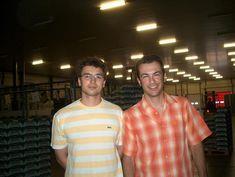
After a lull in production at the start of the millennium, Greek kiwifruit production is back on course, according to George Kallitsis, export manager at Fruits Protofanousis S.A. “Between 1990 and 2000 Greece was among the six top producing countries,” says Kallitsis. “Then there was a decline in the production during the years 2001 to 2003 because of unfavourable weather conditions. But last year’s crop was back to normal and Greece now produces more or less the same volume as France but with an upward trend due to new plantings.”
Thessaloniki-based Fruits Protofanousis S.A. (FP) specialises in the sorting, packing and distribution of a wide variety of fruits. “The company packs and distributes some 8,000 tonnes of kiwifruit, as well as 15,000t of oranges, 4,000t of mandarins, 500t of apricots, 5,000t of watermelons and melons, 3,000t of Victoria grapes, 1,000t of Thomson grapes and 500t of plums,” says Kallitsis. “We have freezing and packing facilities covering a total area of 7,500 square metres, and retain premises in the central vegetable market of Thessaloniki.”
While FP exports the majority of its kiwifruit production, only a small percentage is absorbed by the UK, with the majority entering the rest of Europe. Kallitsis says the company is largely dedicated to supplying retailers, although wholesalers still receive a small volume of fruit, with the ratio between the two markets varying in different countries.
Kiwifruit has long been FP’s main export item and the company exports 75-85 per cent of its crop every year. While Kallitsis says the company has not expanded its volumes for this season, it has been heavily focused on ensuring the quality of its product in order to serve customers with increasingly superior standards. “To support this policy we follow all the necessary quality requirements,” he says. “Our packing house is BRC and IFS certified and the kiwifruit, apricot and plum production will be EurepGap certified.”
The Greek season begins with harvesting at the end of October and lasts until the end of May. “Normally exports finish in the end of April but we aim to prolong exports into May with construction of the new facilities,” Kallitsis claims. FP has plans to build a new packing house with an 8,000t storage capacity in the centre of the main kiwifruit production area in Greece. The plant will be dedicated to the grading, storing and packing of kiwifruit, plums and apricots.
According to Kallitsis the 2004/2005 season began well, but the boom tailed off in the latter months. “The big crop was followed by high export volumes during the months of November to February,” he says. “Prices were considerably lower compared with the year before. The remaining volumes in March were so low, that Italian kiwifruits were imported to cover local demand.”
Kallitsis says consumption of the fruit has reached a plateau in Greece, as well as in the rest of Europe. “Per capita consumption is around 2kg - approximately the same as in Italy, Spain and Portugal.” However, while he is not expecting to see a dramatic increase in demand during the coming years, he says there is room for expansion in the UK market, with consumption still fixed at around 0.5-1kg per head, and in the new EU member states, where consumption is also lower than the European average.
Meanwhile, like the rest of Europe, Greece is very aware of the potential competition coming from the far east. “Everybody is concerned about China’s role as a producer in the next few years,” Kallitsis explains. “They are lacking in infrastructure and only a small percentage of the plantings are of Hayward. However, they are improving very fast.”
In anticipation of the changing global trade situation, FP has already begun to penetrate the south east Asian market and continues to expand its exports in that direction year-on-year. Kallitsis says he is also planning to resurrect the company’s presence in North America and Canada for the coming season.



